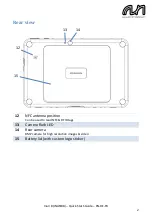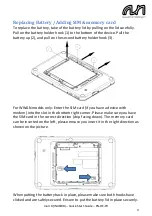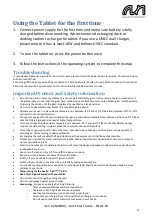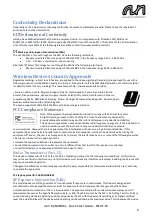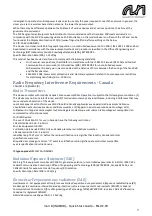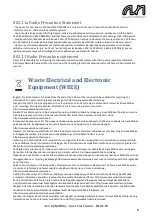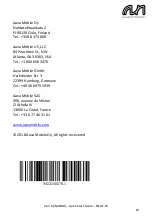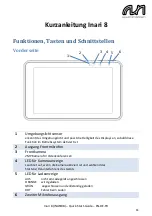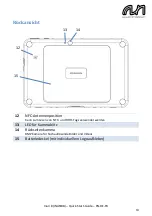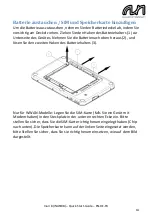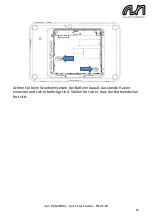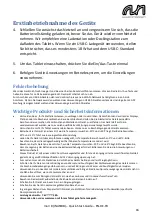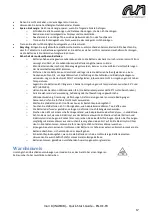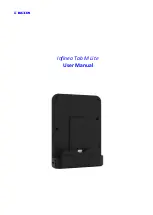
Inari 8 (INARI8B)
–
Quick-Start-Guide
–
EN-DE-FR
6
Conformity Declarations
Depending on the actual model, following conformity / compliance statements are valid. Please check the type label of
your device for further information.
EU Declaration of Conformity
Hereby, Aava Mobile declares that the radio equipment Inari 8 is in compliance with Directive 2011/65/EU and
1999/5/EC or 2014/53/EU (2014/53/EU supersedes 1999/5/EC from 13th June 2017).
The full text of the EU Declaration
of Conformity is available at the following internet address: http://www.aavamobile.com/doc
Marking and European Economic Area (EEA)
The use of RLAN's, for use throughout the EEA, have the following restrictions:
•
Maximum radiated transmit power of 100 mW EIRP in the frequency range 2.400 - 2.4835 GHz
•
5.13 - 5.35 GHz is restricted to indoor use only
Bluetooth® Wireless Technology for use through the EEA has the following restrictions:
•
Maximum radiated transmit power of 100mW EIRP in the frequency range 2.400 -2.4835 GHz
Wireless Devices Country Approvals
Regulatory markings, subject to certification, are applied to the device signifying the radio(s) are approved for use in the
following countries: United States, Canada, and Europe
1
. Please refer to the Aava Mobile Declaration of Conformity (DoC)
for details of other country markings. This is available at http://www.aavamobile.com/doc.
1
Europe includes: Austria, Belgium, Bulgaria, Croatia, Czech Republic, Cyprus, Denmark, Estonia,
Finland, France, Germany, Greece, Hungary, Iceland, Ireland, Italy, Latvia, Liechtenstein, Lithuania,
Luxembourg, Malta, Netherlands, Norway, Poland, Portugal, Romania, Slovak Republic, Slovenia, Spain,
Sweden, Switzerland and the United Kingdom.
The device supports WLAN 5150-5350 MHz with indoor usage restrictions.
FCC Compliance Statement
Note: This equipment has been tested and found to comply with the limits for a Class
B digital device, pursuant to Part 15 of the FCC rules. These limits are designed to
provide reasonable protection against harmful interference in a residential installation.
This equipment generates, uses and can radiate radio frequency energy and, if not installed and
used in accordance with the instructions, may cause harmful interference to radio
communications. However there is no guarantee that interference will not occur in a particular installation. If this
equipment does cause harmful interference to radio or television reception, which can be determined by turning the
equipment off and on, the user is encouraged to try to correct the interference by one or more of the following measures:
• Reorient or relocate the receiving antenna
• Increase the separation between the equipment and receiver
• Connect the equipment into
an outlet on a circuit different from that to which the receiver is connected
• Consult the dealer or an experienced radio/TV technician for help.
Radio Transmitters (Part 15)
This device complies with Part 15 of the FCC Rules. Operation is subject to the following two conditions: (1) this device
may not cause harmful interference, and (2) this device must accept any interference received, including interference that
may cause undesired operation.
Changes or modifications not expressly approved by the part
y responsible for compliance could void the user‘s authority
to operate the equipment.
FCC type approval ID: 2ABVH-INARI8B1
RF Exposure Information (SAR)
This model device meets the government’s requirements for exposure to radio waves. This device is
designed and
manufactured not to exceed the emission limits for exposure to radio frequency (RF) energy set by the Federal
Communications Commission of the U. S. Government. The exposure standard for wireless devices employs a unit of
measurement known as the Specific Absorption Rate, or SAR. The SAR limit set by the FCC is 1.19 W/kg. Tests for SAR are
conducted using standard operating positions accepted by the FCC with the device transmitting at its highest certified
level, the actual SAR level of the device while operating can be well below the maximum value. This is because the device



